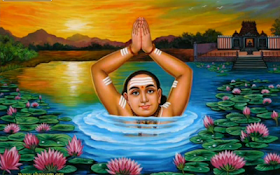Rudra Pasupathi Nayanar was born at Thiruthalayur in a Brahmin family of Vedic Scholars. The Nayanar who was a fervent devotee of the Lord, made a practice of chanting the Sri Rudram, one of the most purifying holy hymns of Lord Shiva standing in neck deep water. He performed this tapas both in the early morning and evening with utmost devotion and faith. Nayanar achieved moksha because of his austere life and perpetual devotion to Lord.
Sri Rudram:
Namakam-Chamakam in Devanagari, English translations
Sri Shiva Rudram: Namakam-Chamakam slokas in Devanagari Sanskrit with English translations.
Sri Rudram is a Hindu strotra dedicated to Rudra (Shiva), taken from the Yajurveda. The text is also famous for its mention of the namah shivaya mantra. Chanting the Rudram is considered to be of great benefit. Legend reports that Lord Shiva, after Bhasmasura was killed with the help of Lord Maha Vishnu, performed the Tandava Dance and then chanted the "Rudra Yagna" at the place where the "Sri Kalahasti" Temple stands now, (one of the 5 Pancha Moorthis).
The story of Rudra Pasupathi Nayanar story goes thus:
“The country watered by the Kaveri is a famed one rich in its fertile fields. Tiruttalaiyur was a city in it, great in its inhabitants of high ancesty, flourishing together, knowing no want. The sacrificial fires of the Brahmins rose up to the skies there (a landmark from afar for celestial bliss), the dense groves rich with blooms dripped honey, the cows yielded the five-fold products meet for the adoration of the dancing Lord. Well this place was the home for benevolence, righteousness and true culture.
The righteous Pasupatiyaar hailed from a noble family of Brahmins dedicated to Vedic learning, in the city. He duly served the Lord of the bull-mount, who gloried in His Better-half, the daughter of the golden mount! With a heart over-flowing with love, he incessantly and zealously chanted the “Rudram” in praise of the Supreme Lord whose feet Vishnu could not divine of yore.
Before the dawn of each day, responding to the twitter of the birds that were astir, and the humming of the bees in the flower groves he would betake himself to the water-brimming pool, where the flaming lotus blooms lifted their heads with leap of flashing fish at the base.
Then he would get into the cool water up to this neck, fold his hands above his head and chant the “Rudram”, in faultles accents, expressive of his love for the Lord of the matted tresses wherein sports the Ganga of the white waves. He would repeat this chant, the essence of the Vedas, at noon and night too, without fail.
Thus he shone like the four-faced Brahma, seated in the lotus-bed. In due course, the Lord who had given his left side joyously to His consort Uma, desired to raise up this saint. The Lord, source of all, was greatly delighted at the rgular chant of the ”mantras” in the prescribed way, in time with the gorious austerity of the passionate devotee and showered His grace on him, who then reached the bounds of the immaculate Abode of the Lord.
By virtue of his faultless chanting of the “Rudram”, with an over-flowing heart, he then found himself close to the dancing feet of the Lord. Therfore, he became known in this wide world by the hallowed name Rudra Pasupatiyaar.
Ah, the Lord of the Trident shows His grace to the loving, perfect chanters of “Sri Rudram”. This is one way to reach up to Him.”

Would you the reason why they stand in water and chant?
ReplyDeletestanding in water stabilises your energies while chanting. The same reason why you have a dip before you enter temples. It makes you a bit more receptive to the energies of the shrine. Try it to see the difference
ReplyDelete